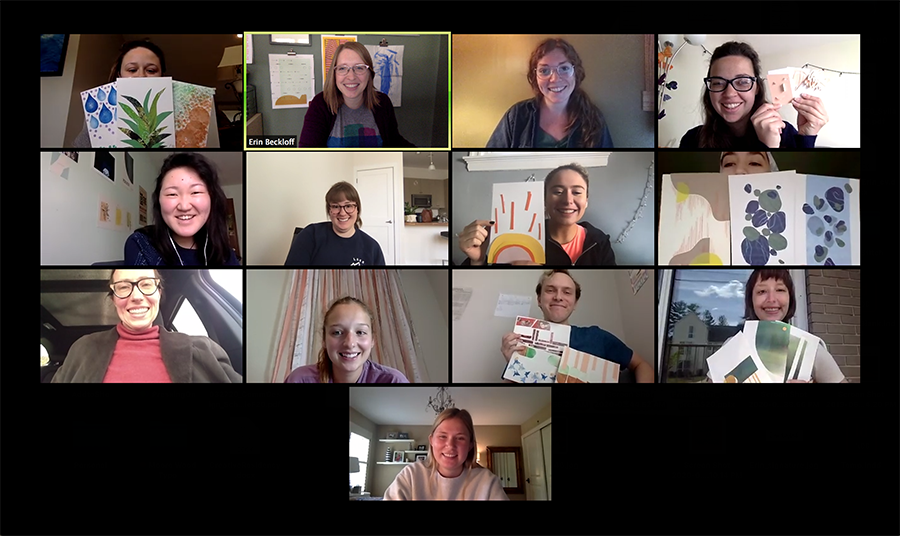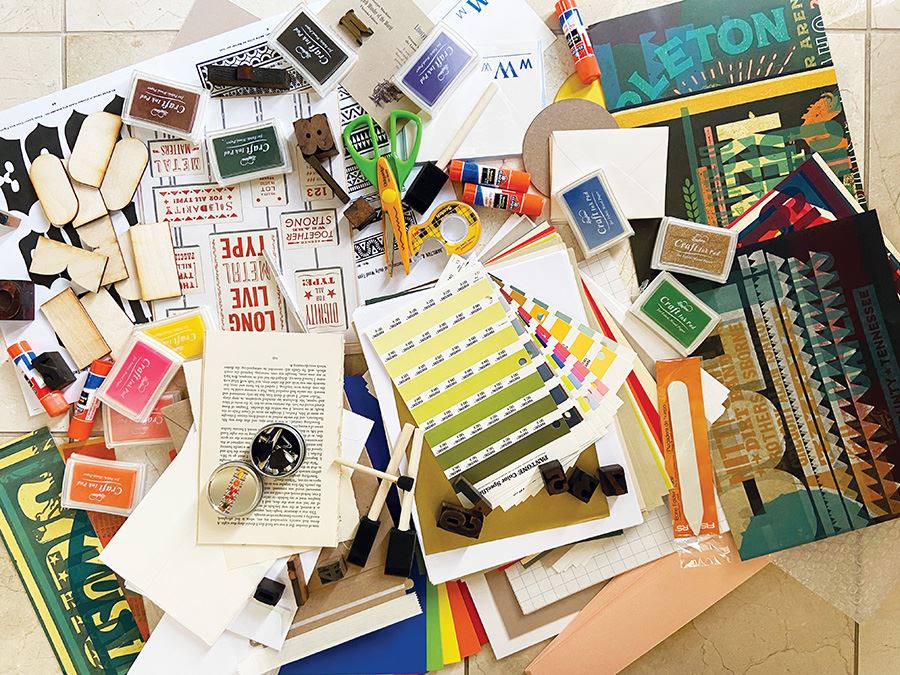
Letterpress Printing students sharing their Small Beauties collage projects created with Visiting Artist Lindsay Schmittle of Gingerly Press.
The COVID-19 pandemic has created unforeseeable challenges, but out of the darkness opportunities have grown for expanded and deeper connections. In Spring 2020 colleges and universities across the world made the unexpected, but wise, choice to move to remote learning. With little to no warning, educators were faced with a difficult transition to the digital environment, particularly studio-based courses that rely on specialized equipment and value physical making processes. Feeling uncertain about how to shift my letterpress printing and design courses, I turned to the printing community as a source of strength and support. I organized virtual meetings for comradery and commiseration, and created a Remote Letterpress Drive to serve as a hub for collaboration. Educators are encouraged to contribute remote teaching materials, and to use, add, and edit content and resources for the benefit of all.
Since early March, people teaching all levels of design, studio art, printmaking, and book arts, as well as representatives from printing museums, libraries, and archives have gathered for conversation. Each session has had about five to twenty participants, and over 70 individuals have attended at least one Letterpress Edu Chat. The international community has continued to grow to an email list of 180 people. Over the summer, a team and I founded LEAD: Letterpress Educators of Art & Design and will continue to host Chats. Email info@letterpresseducators.com if you would like to participate—all are welcome.
Chat sessions have been a time to discuss concerns, celebrate successes, and to offer support. Collective concern includes how to help students feel engaged and not have to rely on digital media while meeting learning outcomes from a distance. Educators discussed the need to provide empathy and flexibility and help students keep making and exercising creativity. The group shared ideas for finding parallel design processes without access to printing presses and type. Taking a digital approach, some faculty used Adobe software to simulate the printing process including the relationship of ink/color and composing with restraints of building a form with a limited type collection. David Wolske of University of North Texas, Globe at MICA, and others generously provided wood type scans, digital files, and typography references to the Shared Drive. Some faculty quickly put together supply kits of materials to DIY print and bind. Others encouraged the use of found materials and honored the role of the hand in the work through collage, stamping, and drawing letterforms. Facilitating collaboration at a distance and hosting virtual visiting printers was another important way educators helped remind students that we are all connected even when apart.

Remote Supply Kit assembled by Beckloff for Letterpress Printing at Miami University for Spring 2020.
Well before the Spring term had ended, discussion in the Letterpress Edu Chats turned to planning for the still uncertain 2020–21 school year. The Provisional Press created by Steve Garst arose as a significant solution for accessibility and adaptability for the continuity of letterpress education. Originally Steve developed the press as open source plans to be built inexpensively for anyone with little wood shop skills and access to a laser cutter. He hoped it would become a transitional press to enable students to continue to print once they no longer had access to studios. In the Provisional Press, the chat participants saw a solution to the need for remote and socially distanced face-to-face teaching. Steve collected feedback through a combination of the Chats and educators building the protypes and testing the presses. With the help of Scott Moore of Moore Wood Type, he adapted the design to fit a standard American galley or steel bed plate, increased the strength and durability, and produced 165 Provisional Press Kits for 21 schools. Other faculty are building over 100 of their own kits from the plans for the Fall term.
In the Chats, we discussed focusing on the importance of proactive planning and collective support of our community to be prepared for our institutional changes and challenges; as well as taking time to reflect on why we teach letterpress printing and letting that inform our future goals. Now more than ever is the time to share resources and expertise, to find and create opportunities within our current situation, and to communicate the value of the letterpress experience for students and institutions. Helen Ingham, Letterpress Technician at Central Saint Martins College of Art & Design, reflected that we all seem to be faced with the same battles, “Often I’ve felt I was in isolation, but now know this is far from the case.”

Character Prints Spring 2020
Maya Fenter, digital letterpress elements: wood type and wood engraving
Delaney Heisterkamp: tissue paper, digital typography
Maggie Walkoff: digitized wood type, hand stamping
Erin Beckloff is a designer, educator, printer and filmmaker (Pressing On 2017) who preserves anecdotal and technical knowledge of printing history and culture with a focus on education and community. She serves as an Assistant Professor of Communication Design at Miami University and has an MFA in Graphic Design from Vermont College of Fine Arts. http://www.erinbeckloff.com/ | @ebecks

